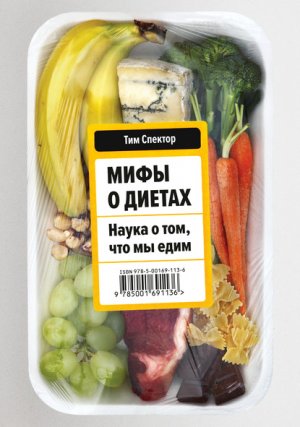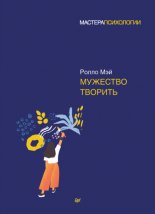Ìèôû î äèåòàõ. Íàóêà î òîì, ÷òî ìû åäèì Ñïåêòîð Òèì

36. Fogelholm, M., Obes Rev (Mar 2010); 11 (3): 202–21. Physical activity, fitness and fatness: relations to mortality, morbidity and disease risk factors.
37. Viloria, M., Immunol Invest (2011); 40: 640–56. Effect of moderate exercise on IgA levels and lymphocyte count in mouse intestine.
38. Matsumoto, M., Biosci, Biotechnol Biochem (2008); 72: 572–6. Voluntary running exercise alters microbiota composition and increases n-butyrate concentration in the rat cecum.
39. Hsu, Y.J., J Strength Cond Res (20 Aug 2014). Effect of intestinal microbiota on exercise performance in mice.
40. Clarke, S.F., Gut (Dec 2014); 63 (12): 1913–20. Exercise and associated dietary extremes impact on gut microbial diversity.
41. Kubera, B., Front Neuroenergetics (8 Mar 2012); 4: 4. The brain’s supply and demand in obesity.
3. Æèðû, èòîãî
1. de Nijs, T., Crit Rev Clin Lab Sci (Nov 2013); 50 (6): 163–71. ApoB versus non-HDL-cholesterol: diagnosis and cardiovascular risk management.
2. Kaur, N., J Food Sci Technol (Oct 2014); 51 (10): 2289–303. Essential fatty acids as functional components of foods, a review.
3. Chowdhury, R., Ann Intern Med (18 Mar 2014); 160 (6): 398–406. Association of dietary, circulating, and supplement fatty acids with coronary risk: a systematic review and meta-analysis.
4. Wrtz, P., Circulation (8 Jan 2015). pii: 114.013116. Metabolite profiling and cardiovascular event risk: a prospective study of three population-based cohorts.
5. Albert, B.B., Sci Rep (21 Jan 2015); 5: 7928. doi: 10.1038/srep07928. Fish oil supplements in New Zealand are highly oxidised and do not meet label content of n-3 PUFA.
6. Ackman, R.G., J Am Oil Chem Soc (1989); 66: 1162–64. EPA and DHA contents of encapsulated fish oil products.
7. Opperman, M., Cardiovasc J Afr (2011); 22: 324–29. Analysis of omega-3 fatty acid content of South African fish oil supplements.
8. Micha, R., BMJ (2014); 348: g2272. Global, regional, and national consumption levels of dietary fats and oils in 1990 and 2010: a systematic analysis including 266 country-specific nutrition surveys.
9. Campbell, T.C., Am J Cardiol (26 Nov 1998); 82 (10B): 18T–21T. Diet, lifestyle, and the etiology of coronary artery disease: the Cornell China study.
10. Campbell, T.C., The China Study (BenBella Books, 2006).
4. Æèðû íàñûùåííûå
1. Law, M., BMJ (1999); 318: 1471–80. Why heart disease mortality is low in France: the time lag explanation.
2. Bertrand, X., J Appl Microbiol (Apr 2007); 102 (4): 1052–9. Effect of cheese consumption on emergence of antimicrobial resistance in the intestinal microflora induced by a short course of amoxicillin-clavulanic acid.
3. https://www.youtube.com/watch?v=134aMOQwyhY.
4. David, L.A., Nature (23 Jan 2014); 505 (7484): 559–63.
5. Teicholz, N., The Big Fat Surprise (Simon & Schuster, 2014)
6. Goldacre, B., BMJ (2014); 349 doi: http://dx.doi.org/10.1136/bmj.g4745. Mass treatment with statins.
7. Harborne, Z., Open Heart (2015); 2: doi: 10.1136/openhrt-2014-000196. Evidence from randomised controlled trials did not support the introduction of dietary fat guidelines in 1977 and 1983: a systematic review and meta-analysis.
8. Siri-Tarino, P.W., Am J Clin Nutr (2010); 91: 535–46. Meta-analysis of prospective cohort studies evaluating the association of saturated fat with cardiovascular disease.
9. Hjerpsted, J., Am J Clin Nutr (2011); 94: 1479–84. Cheese intake in large amounts lowers LDL-cholesterol concentrations compared with butter intake of equal fat content.
10. Rice, B.H., Curr Nutr Rep (15 Mar 2014); 3: 130–38. Dairy and Cardiovascular Disease: A Review of Recent Observational Research.
11. Tachmazidou, I., Nature Commun (2013); 4: 2872. A rare functional cardioprotective APOC3 variant has risen in frequency in distinct population isolates.
12. Minger, D., Death by Food Pyramid (Primal Blueprint, 2013).
13. Chen, M., Am J Clin Nutr (Oct 2012); 96 (4): 735–47. Effects of dairy intake on body weight and fat: a meta-analysis of randomized controlled trials.
14. Martinez-Gonzalez, M., Nutr Metab Cardiovasc Dis (Nov 2014); 24 (11): 1189–96. Yogurt consumption, weight change and risk of overweight/obesity: the SUN cohort.
15. Jacques, P., Am J Clin Nutr (May 2014); 99 (5): 1229S–34S. Yogurt and weight management.
16. Kano, H., J Dairy Sci (2013); 96: 3525–34. Oral administration of Lactobacillus delbrueckii subspecies bulgaricus OLL1073R-1 suppresses inflammation by decreasing interleukin-6 responses in a murine model of atopic dermatitis.
17. Daneman, N., Lancet (12 Oct 2013); 382 (9900): 1228–30. A probiotic trial: tipping the balance of evidence?
18. Guo, Z., Nutr Metab Cardiovasc Dis (2011); 21: 844–50. Influence of consumption of probiotics on the plasma lipid profile: a meta-analysis of randomised controlled trials.
19. Jones, M.L., Br J Nutr (May 2012); 107 (10): 1505–13. Cholesterol-lowering efficacy of a microencapsulated bile salt hydrolase-active Lactobacillus reutei NCIMB 30242 yoghurt formulation in hypercholesterolaemic adults.
20. Jones, M.L., Eur J Clin Nutr (2012); 66: 1234–41. Cholesterol lowering and inhibition of sterol absorption by Lactobacillus reuteri NCIMB 30242: a randomized controlled trial.
21. Morelli, L., Am J Clin Nutr (2014); 99 (suppl): 1248S–50S. Yogurt, living cultures, and gut health.
22. McNulty, N.P., Sci Transl Med (26 Oct 2011); 3: 106. The impact of a consortium of fermented milk strains on the gut microbiome of gnotobiotic mice and monozygotic twins.
23. Goodrich, J.K., Cell (6 Nov 2014); 159 (4): 789–99. Human genetics shape the gut microbiome.
24. Roederer, M., The Genetic Architecture of the Human Immune System (Cell, 2015).
25. Saulnier, D.M., Gut Microbes (Jan–Feb 2013); 4 (1): 17–27. The intestinal microbiome, probiotics and prebiotics in neurogastroenterology.
26. De Palma, G., Gut Microbes (May–Jun 2014); 5 (3): 439–45. The microbiota-gut-brain axis in functional gastrointestinal disorders.
27. Sachdev, A.H., Curr Gastroenterol Rep (Oct 2012); 14 (5): 439–45. Antibiotics for irritable bowel syndrome.
28. Roederer, M., The Genetic Architecture of the Human Immune System (Cell, 2015).
29. Tillisch, K., Gastroenterology (Jun 2013); 144 (7): 1394–401. Consumption of fermented milk product with probiotic modulates brain activity.
30. Tillisch, K., Gut Microbes (May–Jun 2014); 5 (3): 404–10. The effects of gut microbiota on CNS function in humans.
5. Æèðû íåíàñûùåííûå
1.  ñòèõîòâîðåíèè òàêæå ìîæåò èäòè ðå÷ü îá óâåëè÷åíèè íàëîãîâ (íåïîïóëÿðíîé ìåðå Êàðëà I è Ãåíðèåòòû-Ìàðèè) èëè äàæå î áîëåå ðàííåì ñïîðå ìåæäó êîðîëåì Ðè÷àðäîì è åãî áðàòîì Äæîíîì.
2. Daniel, C.R., Public Health Nutr (Apr 2011); 14 (4): 575–83. Trends in meat consumption in the United States.
3. http://www.eblex.org.uk/wp/wp-content/uploads/2014/02/m_uk_yearbook13_Cattle110713.pdf.
4. Micha, R., Lipids (Oct 2010); 45 (10): 893–905. Saturated fat and cardiometabolic risk factors, coronary heart disease, stroke, and diabetes: a fresh look at the evidence.
5. Siri-Tarino, P.W., Am J Clin Nutr (2010); 91: 535–46. Meta-analysis of prospective cohort studies evaluating the association of saturated fat with cardiovascular disease.
6. Price, W.A., Nutrition and Physical Degeneration, 6th edn (La Mesa, Ca, Price-Pottenger Nutritional Foundation, 2003).
7. Willett, W.C., Am J Clin Nutr (Jun 1995); 61 (6 Suppl): 1402S–6S. Mediterranean diet pyramid: a cultural model for healthy eating.
8. Estruch, R., N Engl J Med (4 Apr 2013); 368 (14): 1279–90. Primary prevention of cardiovascular disease with a Mediterranean diet.
9. Salas-Salvad, J., Ann Intern Med (7 Jan 2014); 160 (1): 1–10. Prevention of diabetes with Mediterranean diets: a subgroup analysis of a randomized trial.
10. Guasch-Ferr, M., BMC Med (2014); 12: 78. Olive oil intake and risk of cardiovascular disease and mortality in the PREDIMED Study.
11. Konstantinidou, V., FASEB J (Jul 2010); 24 (7): 2546–57. In vivo nutrigenomic effects of virgin olive oil polyphenols within the frame of the Mediterranean diet: a randomized controlled trial.
12. Lanter, B.B., MBio (2014); 5 (3): e01206–14. Bacteria present in carotid arterial plaques are found as biofilm deposits which may contribute to enhanced risk of plaque rupture.
13. Vallverd-Queralt, A., Food Chem (15 Dec 2013); 141 (4): 3365–72. Bioactive compounds present in the Mediterranean sofrito.
6. Òðàíñæèðû
1. https://www.youtube.com/watch?v=zrv78nG9R04.
2. Lam, H.M., Lancet (8 Jun 2013); 381 (9882): 2044–53. Food supply and food safety issues in China.
3. Mozaffarian, D., N Engl J Med (2006); 354: 1601–13. Trans fatty acids and cardiovascular disease.
4. Kris-Etherton, P.M., Lipids (Oct 2012); 47 (10): 931–40. Trans fatty acid intakes and food sources in the U.S. population: NHANES 1999–2002.
5. Thomas, L.H., Am J Clin Nutr (1981); 34: 877–86. Hydrogenated oils and fats: the presence of chemically-modified fatty acids in human adipose tissue.
6. Iqbal, M.P., Pak J Med Sci (Jan 2014); 30 (1): 194–7. Trans fatty acids — a risk factor for cardiovascular disease.
7. Kishino, S., Proc Natl Acad Sci (29 Oct 2013); 110 (44): 17808–13. Polyunsaturated fatty acid saturation by gut lactic acid bacteria affecting host lipid composition.
8. Pacifico, L., World J Gastroenterol (21 Jul 2014); 20 (27): 9055–71. Nonalcoholic fatty liver disease and the heart in children and adolescents.
9. Mozaffarian, D., N Engl J Med (3 Jun 2011); 364 (25): 2392–404. Changes in diet and lifestyle and long-term weight gain in women and men.
11. Moss, M., Salt, Sugar, Fat: How the Food Giants Hooked Us (WH Allen, 2013).
12. Johnson, P.M., Nat Neurosci (May 2010); 13 (5): 635–41. Dopamine D2 receptors in addiction-like reward dysfunction and compulsive eating in obese rats.
13. Avena, N.M., Methods Mol Biol (2012); 829: 351–65. Animal models of sugar and fat bingeing: relationship to food addiction and increased body weight.
14. Taylor, V.H., CMAJ (9 Mar 2010); 182 (4): 327–8. The obesity epidemic: the role of addiction.
15. Bayol, S.A., Br J Nutr (Oct 2007); 98 (4): 843–51. A maternal ‘junk food’ diet in pregnancy and lactation promotes an exacerbated taste for ‘junk food’ and a greater propensity for obesity in rat off spring.
16. David, L.A., Nature (23 Jan 2014); 505 (7484): 559–61. Diet rapidly and reproducibly alters the human gut microbiome.
17. Poutahidis, T., PLoS One (Jul 2013); 10; 8 (7): e68596. Microbial reprogramming inhibits Western diet-associated obesity.
18. Martinez-Medina, M., Gut (Jan 2014); 63 (1): 116–24. Western diet induces dysbiosis with increased E coli in CEABAC10 mice, alters host barrier function favouring AIEC colonisation.
19. Huh, J.Y., Mol Cells (May 2014); 37 (5): 365–71. Crosstalk between adipocytes and immune cells in adipose tissue inflammation and metabolic dysregulation in obesity.
20. Wang, J., ISME J (2015) 9: 1–15; Modulation of gut microbiota during probiotic-mediated attenuation of metabolic syndrome in high-fat-diet-fed mice.
21. Cox, A.J., Lancet Diabetes Endocrinol (Jul 2014); 21.pii: S2213–8587. Obesity, inflammation, and the gut microbiota.
22. Mraz, M., J Endocrinol (8 Jul 2014); pii: JOE-14-0283. The role of adipose tissueimmune cells in obesity and low-grade inflammation.
23. Kong, L.C., PLoS One (Oct 2014); 20; 9 (10): e109434. Dietary patterns differently associate with inflammation and gut microbiota in overweight and obese subjects.
24. Ridaura, V.K., Science (6 Sep 2013); 341 (6150): 1241214. Gut microbiota from twins discordant for obesity modulate metabolism in mice.
25. Goodrich, J.K., Cell, (Nov 2014); 159 (4): 789–99. Human genetics shape the gut microbiome.
26. Fei, N., ISME J (2013); 7: 880–4. An opportunistic pathogen isolated from the gut of an obese human causes obesity in germ-free mice.
27. Backhed, F., Proc Natl Acad Sci USA (2004); 101: 15718–15723. The gut microbiota as an environmental factor that regulates fat storage.
28. Backhed, F., Proc Natl Acad Sci USA (2007); 104: 979–84. Mechanisms underlying the resistance to diet-induced obesity in germ-free mice.
29. http://www.youtube.com/watch?v=gzL0fRkqjK8.
30. Xiao, S., FEMS Microbiol Ecol (Feb 2014); 87 (2): 357–67. A gut microbiota-targeted dietary intervention for amelioration of chronic inflammation underlying metabolic syndrome.
31. Zhou, H., Dongjin Dynasty (Tianjin Science & Technology Press, 2000).
32. Zhang, X., PLoS One (2012); 7 (8): e42529. Structural changes of gut microbiota during berberine-mediated prevention of obesity and insulin resistance in high-fat diet-fed rats.
33. http://www.sciencemag.org/content/342/6162/1035.
34. Alcock, J., Bioessays (8 Aug 2014); doi: 10.1002/bies.201400071. Is eating behavior manipulated by the gastrointestinal microbiota? Evolutionary pressures and potential mechanisms.
35. Vijay-Kumar, M., Science (9 Apr 2010); 328 (5975): 228–31. Metabolic syndrome and altered gut microbiota in mice lacking Toll-like receptor 5.
36. Shin, S.C., Science (2011); 334 (6056): 670–4. Drosophila microbiome modulates host developmental and metabolic homeostasis via insulin signalling.
37. Tremaroli, V., Nature (13 Sep 2012); 489 (7415): 242–9. Functional interactions between the gut microbiota and host metabolism.
7. Áåëêè æèâîòíîãî ïðîèñõîæäåíèÿ
1. Diamond, J., Guns, Germs and Steel (Norton, 1997).
2. Atkins, R., The Diet Revolution (Bantam Books, 1981).
3. Bueno, N.B., Br J Nutr (Oct 2013); 110 (7): 1178–87. Very-low carbohydrate ketogenic diet v. low-fat diet for long-term weight loss: a meta-analysis of randomised controlled trials.
4. Paoli, A., Int J Environ Res Public Health (19 Feb 2014); 11 (2): 2092–107. Ketogenic diet for obesity: friend or foe?
5. Douketis, J.D., Int J Obes (2005); 29 (10): 1153–67. Systematic review of long-term weight loss studies in obese adults: clinical significance and applicability to clinical practice.
6. Ebbeling, C.B., JAMA (27 Jun 2012); 307 (24): 2627–34. Effects of dietary composition on energy expenditure during weight-loss maintenance.
7. Ebbeling, C.B., JAMA (27 Jun 2012); 307 (24): 2627–34. Effects of dietary composition on energy expenditure during weight-loss maintenance.
8. Ellenbroek, J.H., Am J Physiol Endocrinol Metab (1 Mar 2014); 306 (5): E552-8. Long-term ketogenic diet causes glucose intolerance and reduced beta and alpha cell mass but no weight loss in mice.
9. Cotillard, A., Nature (29 Aug 2013); 500 (7464): 585–8. Dietary intervention impact on gut microbial gene richness.
10. Le Chatelier, E., Nature (29 Aug 2013); 500 (7464): 541–6. Richness of human gut microbiome correlates with metabolic markers.
11. Qin, J., Nature (4 Oct 2012); 490 (7418): 55–60. A metagenome-wide association study of gut microbiota in type 2 diabetes.
12. Fraser, G.E., Arch Intern Med (2001); 161: 1645–52. Ten years of life: is it a matter of choice?
13. Le, L.T., Nutrients (27 May 2014); 6 (6): 2131–47. Beyond meatless, the health effects of vegan diets: findings from the Adventist cohorts.
14. Boomsma, D.I., Twin Res (Jun 1999); 2 (2): 115–25. A religious upbringing reduces the influence of genetic factors on disinhibition: evidence for interaction between genotype and environment on personality.
15. Key, T.J., Am J Clin Nutr (2009); 89; 1613S–19S. Mortality in British vegetarians: results from the European Prospective Investigation into Cancer and Nutrition (EPIC Oxford).
16. Key, T.J., Am J Clin Nutr (Jun 2014); 100 (Supplement 1): 378S–85S. Cancer in British vegetarians.
17. http://crossfitanaerobicinc.com/paleo-nutrition/list-of-foods/.
18. Hidalgo, G., Am J Hum Biol (10 Sep 2014); 26 (5): 710–12. The nutrition transition in the Venezuelan Amazonia: increased overweight and obesity with transculturation.
19. Schnorr, S.L., Nat Commun (15 Apr 2014); 5: 3654.doi: 10.1038/ncomms4654. Gut microbiome of the Hadza hunter-gatherers.
20. Dominguez-Bello, G., Personal communication.
21. Pan, A., Arch Intern Med (9 Apr 2012); 172 (7): 555–63. Red meat consumption and mortality: results from 2 prospective cohort studies.
22. Rohrmann, S., BMC Med (7 Mar 2013); 11: 63.doi: 10.1186/1741-7015-11-6. Meat consumption and mortality — results from the European Prospective Investigation into Cancer and Nutrition.
23. Lee, J.E., Am J Clin Nutr (Oct 2013); 98 (4): 1032–41. Meat intake and cause-specific mortality: a pooled analysis of Asian prospective cohort studies.
24. Tang, W.W., N Engl J Med (25 Apr 2013); 368 (17): 1575–84. Intestinal microbial metabolism of phosphatidylcholine and cardiovascular risk.
25. Brown, J.M., Curr Opin Lipidol (Feb 2014); 25 (1): 48–53. Metaorganismal nutrient metabolism as a basis of cardiovascular disease.
26. Kotwal, S., Circ Cardiovasc Qual Outcomes (2012); 5: 808–18. Omega 3 fatty acids and cardiovascular outcomes: systematic review and meta-analysis.
27. Mozaffarian, D., JAMA (2006); 296 (15): 1885–99. Fish intake, contaminants, and human health: evaluating the risks and the benefits.
28. Lajous, M., Am J Epidemiol (1 Aug 2013); 178 (3): 382–91. Changes in fish consumption in midlife and the risk of coronary heart disease in men and women.
30. Karimian, J., J Res Med Sci (Oct 2011); 16 (10): 1347–53. Supplement consumption in bodybuilder athletes.
31. O’Dea, K., Diabetes (1984); 33: 596–603. Marked improvement in carbohydrate and lipid metabolism in diabetic Australian Aborigines after temporary reversion to traditional lifestyle.
32. http://www.theguardian.com/lifeandstyle/2013/may/12/type-2-diabetesdiet-cure.
33. Look AHEAD Research Group, N Engl J Med (2013); 369: 145–54. Cardiovascular effects of intensive lifestyle intervention in Type 2 diabetes.
34. Franco, M., BMJ (9 Apr 2013); 346: f1515. Population-wide weight loss and regain in relation to diabetes burden and cardiovascular mortality in Cuba 1980–2010.
35. Mann, G.V., J Atheroscler Res (Jul–Aug 1964); 4: 289–312. Cardiovascular disease in the Masai.
8. Áåëêè íåæèâîòíîãî ïðîèñõîæäåíèÿ
1. Frankenfeld, C.L., Am J Clin Nutr (May 2011); 93 (5): 1109–16. Dairy consumption is a significant correlate of urinary equol concentration in a representative sample of US adults.
2. Fritz, H., PLoS One (28 Nov 2013); 8 (11): e81968. Soy, red clover and isoflavones, and breast cancer: a systematic review.
3. Lampe, J.W., J Nutr (Jul 2010); 140 (7): 1369S–72S. Emerging research on equol and cancer.
4. Soni, M., Maturitas (Mar 2014); 77 (3): 209–20. Phytoestrogens and cognitive function: a review.
5. Spector, T.D., Lancet (1982). Coffee, soya and cancer of the pancreas (letter).
6. Tsuchihashi, R., J Nat Med (Oct 2008); 62 (4): 456–60. Microbial metabolism of soy isoflavones by human intestinal bacterial strains.
7. Renouf, M., J Nutr (Jun 2011); 141 (6): 1120–6. Bacteroides uniformis is a putative bacterial species associated with the degradation of the isofl avone genistein in human feces.
8. Pudenz, M., Nutrients (15 Oct 2014); 6 (10): 4218–72. Impact of soy isoflavones on the epigenome in cancer prevention.
9. Hehemann, J.H., Nature (8 Apr 2010); 464 (7290): 908–12. Transfer of carbohydrate-active enzymes from marine bacteria to Japanese gut microbiota.
10. Crisp, A., Genome Biol (13 Mar 2015); 16 (1): 50. Expression of multiple horizontally acquired genes is a hallmark of both vertebrate and invertebrate genomes.
11. Cantarel, B.L., PLoS One (2012); 7 (6): e28742. Complex carbohydrate utilization by the healthy human microbiome.
12. Georg, J.M., Obes Rev (Feb 2013); 14 (2): 129–44. Review: efficacy of alginate supplementation in relation to appetite regulation and metabolic risk factors: evidence from animal and human studies.
13. Brown, E.S., Nutr Rev (Mar 2014); 72 (3): 205–16. Seaweed and human health.
14. Hehemann, J.H., Proc Natl Acad Sci (27 Nov 2012); 109 (48): 19786–91. Bacteria of the human gut microbiome catabolize red seaweed glycans with carbohydrate-active enzyme updates from extrinsic microbes.
15. Pirotta, M., BMJ (4 Sep 2004); 329 (7465): 548. Effect of lactobacillus in preventing post-antibiotic vulvovaginal candidiasis: a randomised controlled trial.
16. Dey, B., Curr HIV Res (Oct 2013); 11 (7): 576–94. Protein-based HIV-1 microbicides.
17. Wang, J., J Nutr (Jan 2014); 144 (1): 98–105. Dietary supplementation with white button mushrooms augments the protective immune response to Salmonella vaccine in mice.
18. Varshney, J., J Nutr (Apr 2013); 143 (4): 526–32. White button mushrooms increase microbial diversity and accelerate the resolution of Citrobacter rodentium infection in mice.
9. Áåëêè èç ìîëî÷íûõ ïðîäóêòîâ
1. Campbell, T.C., Am J Cardiol (26 Nov 1998); 82 (10B): 18T–21T. Diet, lifestyle, and the etiology of coronary artery disease: the Cornell China Study.
2. Minger, D., Dairy consumption in rural China; http://rawfoodsos.com/2010/07/07/the-china-study-fact-or-fallac/.
3. Madani, S., Nutrition (May 2000); 16 (5): 368–75. Dietary protein level and origin (casein and highly purified soybean protein) affect hepatic storage, plasma lipid transport, and antioxidative defense status in the rat.
4. Brssow, H., Environ Microbiol (Aug 2013); 15 (8): 2154–61. Nutrition, population growth and disease: a short history of lactose.
5. Savaiano, D.A., Am J Clin Nutr (May 2014); 99 (5 Suppl): 1251S–5S. Lactose digestion from yogurt: mechanism and relevance.
6. Tishkoff, S.A., Nat Genet (2007); 39: 31–40. Convergent adaptation of human lactase persistence in Africa and Europe.
7. Spector, T., Identically Different (Weidenfeld & Nicolson, 2012).
8. Quigley, L., FEMS Microbiol Rev (Sep 2013); 37 (5): 664–98. The complex microbiota of raw milk.
9. Bailey, R.K., J Natl Med Assoc (Summer 2013); 105 (2): 112–27. Lactose intolerance and health disparities among African Americans and Hispanic Americans: an updated consensus statement.
10. Suchy, F.J., NIH Consensus State Sci Statements (24 Feb 2010); 27 (2): 1–27. NIH consensus development conference statement: Lactose intolerance and health.
11. Petschow, B., Ann NY Acad Sci (Dec 2013); 1306: 1–17. Probiotics, prebiotics, and the host microbiome: the science of translation.
12. Prentice, A.M., Am J Clin Nutr (May 2014); 99 (5 Suppl): 1212S–16S. Dairy products in global public health.
13. Silventoinen, K., Twin Res (Oct 2003); 6 (5): 399–408. Heritability of adult body height: a comparative study of twin cohorts in eight countries.
14. Wood, A.R., Nat Genet (5 Oct 2014); doi: 10.1038/ng.3097. Defining the role of common variation in the genomic and biological architecture of adult human height.
15. Floud, R., The Changing Body: New Approaches to Economic and Social History (Cambridge University Press, 2011).
16. http://www.ers.usda.gov/media/1118789/err149.pdf.
17. Quigley, L., J Dairy Sci (Aug 2013); 96 (8): 4928–37. The microbial content of raw and pasteurized cow’s milk as determined by molecular approaches.
18. Pottenger, F.M., Pottenger’s Cats: A Study in Nutrition (Price Pottenger Nutrition, 1995).
19. Scher, J.U., eLife (Nov 2013); 5; 2: e01202. Expansion of intestinal Prevotella copri correlates with enhanced susceptibility to arthritis.
10. Óãëåâîäû, èç íèõ ñàõàðà
2. Locke, A.E., Nature (12 Feb 2015); 518 (7538): 197-206. Genetic studies of body mass index yield new insights for obesity biology.
3. Qi, Q., N Engl J Med (11 Oct 2012); 367 (15): 1387–96. Sugar-sweetened beverags and genetic risk of obesity.
4. Keskitalo, K., Am J Clin Nutr (Aug 2008); 88 (2): 263–71. The Three-Factor Eating Questionnaire, body mass index, and responses to sweet and salty fatty foods: a twin study of genetic and environmental associations.
5. Keskitalo, K., Am J Clin Nutr (Dec 2007); 86 (6): 1663–9. Same genetic components underlie different measures of sweet taste preference.
6. http://www.who.int/nutrition/sugars_public_consultation/en/.
7. Yudkin, J., Pure, White and Deadly, reissue edn (Penguin, 2012).
8. Wilska, A., Duodecim (1947); 63: 449–510. Sugar caries — the most prevalent disease of our century.
9. Sheiham, A., Int J Epidemiol (Jun 1984); 13 (2): 142–7. Changing trends in dental caries.
10. Birkeland, J.M., Caries Res (Mar–Apr 2000); 34 (2): 109–16. Some factors associated with the caries decline among Norwegian children and adolescents: age-specific and cohort analyses.
11. Masadeh, M., J Clin Med Res (2013); 5.5: 389–94. Antimicrobial activity of common mouthwash solutions on multidrug-resistance bacterial biofilms.
12. Kapil, V., Free Radic Biol Med (Feb 2013); 55: 93–100. Physiological role for nitrate-reducing oral bacteria in blood pressure control.
13. Fine, D.H., Infect Immun (May 2013); 81 (5): 1596–605. A lactotransferrin single nucleotide polymorphism demonstrates biological activity that can reduce susceptibility to caries.
14. Holz, C., Probiotics Antimicrob Proteins (2013); 5: 259–63. Lactobacillus paracasei DSMZ16671 reduces mutans streptococci: a short-term pilot study.
15. Teanpaisan, R., Clin Oral Investig (Apr 2014); 18 (3): 857–62. Lactobacillus paracasei SD1, a novel probiotic, reduces mutans streptococci in human volunteers: a randomized placebo-controlled trial.
16. Glavina, D., Coll Antropol (Mar 2012); 36 (1): 129–32. Effect of LGG yoghurt on Streptococcus mutans and Lactobacillus spp. salivary counts in children.
17. Marcenes, W., J Dent Res (Jul 2013); 92 (7): 592–7. Global burden of oral conditions in 1990–2010: a systematic analysis.
18. Bernab, E., Am J Public Health (Jul 2014); 104 (7): e115–21. Age, period and cohort trends in caries of permanent teeth in four developed countries.
19. Bray, G.A., Am J Clin Nutr (2004); 79: 537–43. Consumption of high-fructose corn syrup in beverages may play a role in the epidemic of obesity.
20. Ng, S.W., Br J Nutr (Aug 2012); 108 (3): 536–51. Patterns and trends of beverage consumption among children and adults in Great Britain, 1986–2009.
21. Bray, G.A., Am J Clin Nutr (2004); 79: 537–43. Consumption of high-fructose corn syrup in beverages may play a role in the epidemic of obesity.
22. Hu, F.B., Physiol Behav (2010); 100: 47–54. Sugar-sweetened beverages and risk of obesity and Type 2 diabetes: epidemiologic evidence.
23. Mitsui, T., J Sports Med Phys Fitness (Mar 2001); 41 (1): 121–3. Colonic fermentation after ingestion of fructose-containing sports drink.
24. Bergheim, I., J Hepatol (Jun 2008); 48 (6): 983–92. Antibiotics protect against fructose-induced hepatic lipid accumulation in mice: role of endotoxin.






